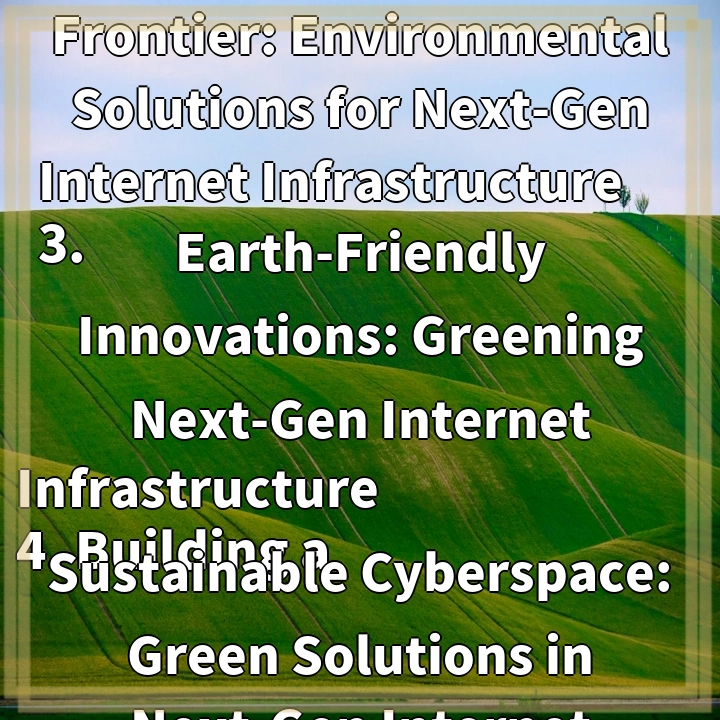
Unleashing Sustainability: Green Solutions for Next-Gen Internet Infrastructure
What it is:
Next-Gen Internet Infrastructure refers to the advanced and evolving network technologies and systems that support our digital world. It encompasses the hardware, software, data centers, and communication networks that enable the seamless flow of information and services across the internet. Green solutions in this context aim to address the environmental impact of these infrastructures and promote sustainability in the ever-expanding digital landscape.
Real-World Problems:
As we become increasingly reliant on digital technologies, the demand for internet infrastructure continues to grow rapidly. However, this growth comes with several environmental challenges that need to be addressed urgently. Some of the key problems associated with next-gen internet infrastructure are as follows:
Inefficient Energy Consumption:
The massive power requirements of data centers, network equipment, and cloud computing operations contribute significantly to carbon emissions and energy consumption. Inefficient cooling systems and outdated hardware further exacerbate this issue. Finding sustainable and energy-efficient solutions is critical to reducing the carbon footprint of internet infrastructure.
E-Waste Management:
Rapid technological advancements and shorter product lifecycles create a substantial amount of electronic waste. Old routers, switches, and data center components that are replaced or upgraded contribute to landfill waste, hazardous materials, and the depletion of valuable resources. Implementing effective e-waste management strategies and promoting device recycling are essential for minimizing environmental harm.
Carbon Footprint of Data Centers:
Data centers are the backbone of the internet. However, they consume massive amounts of energy and generate a significant carbon footprint. The energy-intensive operations of these centers, including cooling and power distribution, contribute to greenhouse gas emissions. Developing energy-efficient data centers powered by renewable energy sources is crucial to reducing their environmental impact.
Resource Depletion:
The production of networking equipment, such as servers, routers, and fiber optic cables, requires significant amounts of raw materials and energy. The extraction, processing, and disposal of these resources contribute to deforestation, pollution, and habitat destruction. Implementing circular economy principles, including recycling and reusing materials, can help minimize resource depletion.
In the upcoming sections, we will explore the innovative green solutions and environmentally friendly initiatives that can address these real-world problems associated with next-gen internet infrastructure.

Unleashing Sustainability: Green Solutions for Next-Gen Internet Infrastructure
Solutions:
1. Energy Efficiency and Renewable Energy:
Implementing energy-efficient practices in data centers, such as utilizing advanced cooling techniques and optimizing server utilization, can significantly reduce energy consumption. Integration of renewable energy sources, like solar and wind power, can also help in achieving carbon-neutral or carbon-negative operations.
2. E-Waste Management and Recycling:
Establishing effective e-waste management systems that prioritize recycling and refurbishment helps reduce electronic waste and the associated environmental impacts. Encouraging manufacturers to design products with longer lifecycles and easier recyclability can also contribute to the reduction of electronic waste.
3. Sustainable Data Center Design:
Adopting sustainable building and infrastructure design practices for data centers, like utilizing natural cooling methods, optimizing airflow, and utilizing energy-efficient hardware, can significantly reduce the carbon footprint of these facilities. Modular and scalable designs can ensure resource efficiency and flexibility for future growth.
4. Circular Economy Practices:
Promoting the circular economy in the production and disposal of networking equipment can minimize resource depletion and waste generation. Encouraging manufacturers to use recycled materials, designing for easy disassembly and repair, and facilitating the recycling and repurposing of equipment at the end of its lifecycle are important steps towards a circular model.
5. Policy and Industry Collaborations:
Engaging policymakers, industry leaders, and stakeholders in collaborative efforts is key to driving sustainable practices. Establishing guidelines, regulations, and certifications for energy efficiency, e-waste management, and sustainable design can incentivize companies to adopt green solutions. Industry collaborations can also foster knowledge sharing and innovation in making next-gen internet infrastructure sustainable.
By implementing these solutions, we can address the real-world problems associated with next-gen internet infrastructure and move towards a greener and more sustainable digital future.















